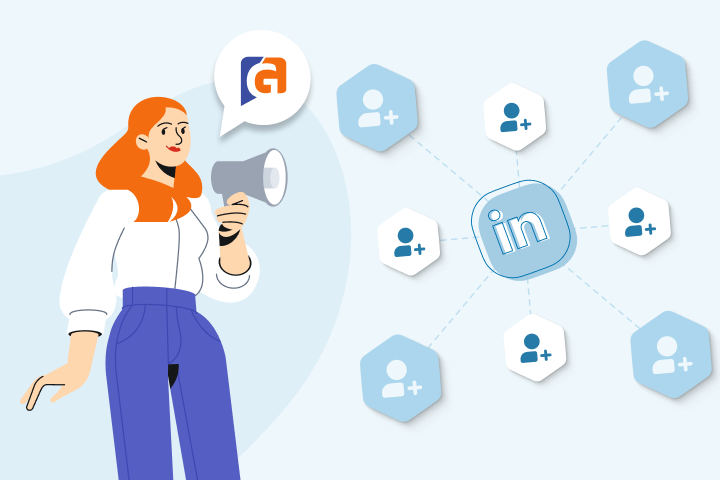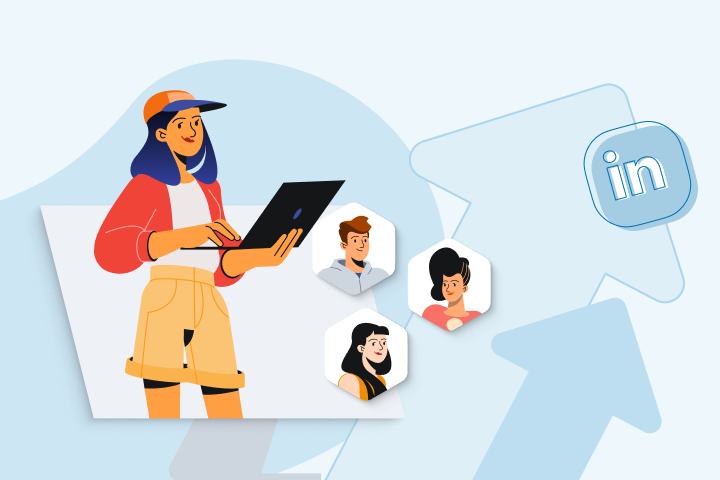How to Build a Global Social Media Marketing Strategy
A global social media marketing strategy requires social media managers to consider a variety of logistical challenges that smaller companies don’t need to think about, like:
- Do I need to create localized social media accounts?
- How do I stay up-to-date with international cultural events?
- How do I handle translations?
- How do I build an international team?
So in this post, we’ll discuss the logistical aspects of how you can implement solid systems and processes to ensure that your global social media marketing strategy is effective.
Do You Need to Create Localized Social Media Accounts?
Many global brands operate with a single social media account for all regions, though others have localized social media accounts for each region.
To help you decide whether or not you should have a single branded account or multiple localized accounts, here are a few questions to consider:
- Does your product/service change depending on your location?
- Are you trying to create social change in those regions?
- What percentage of your target audience is from different regions?
If you're still not sure if you should create localized social media accounts, here are a few pros and cons to each side.
Pros of Localized Social Media Accounts
- Improved Content Relevancy: If you create social media content for specific regions, you can personalize it to the pain points of people from those regions. You'll also be able to promote products and services specific to that geographic region.
- Better Customer Interactions: Customers will probably message you in their native languages, so having someone from that location on duty to answer their questions in their language is helpful.
- Accurate Translations: Hiring a localized account manager ensures that translations are not only grammatically correct, but also make sense and are optimized for their local dialect.
Cons to Localized Social Media Accounts
- More Expensive: We recommend hiring a local content manager to ensure translations and cultural nuances are accurate. While this means you can create more targeted content, it also usually means you'll need a bigger budget.
- Coordination Challenges: Given that you'll be hiring a local content manager, you'll need a bigger social media team and more coordination responsibilities. Time zone differences can also make work challenging.
Before you make a choice, we'll discuss each social media platform's global and localization options.
Facebook now offers Global pages to qualifying businesses, and here's how it defines them:
"Global Pages is a framework which enables brands and businesses to provide localized versions of their content for their customers all over the world. With Global Pages, you can maintain one universal brand name, total fan count, vanity URL, and global insights across your entire fan base."
Meta uses the visitor's IP address to determine which version of the global page to serve. So even if an American is visiting Mexico, that person will still see the American version of your Facebook page.
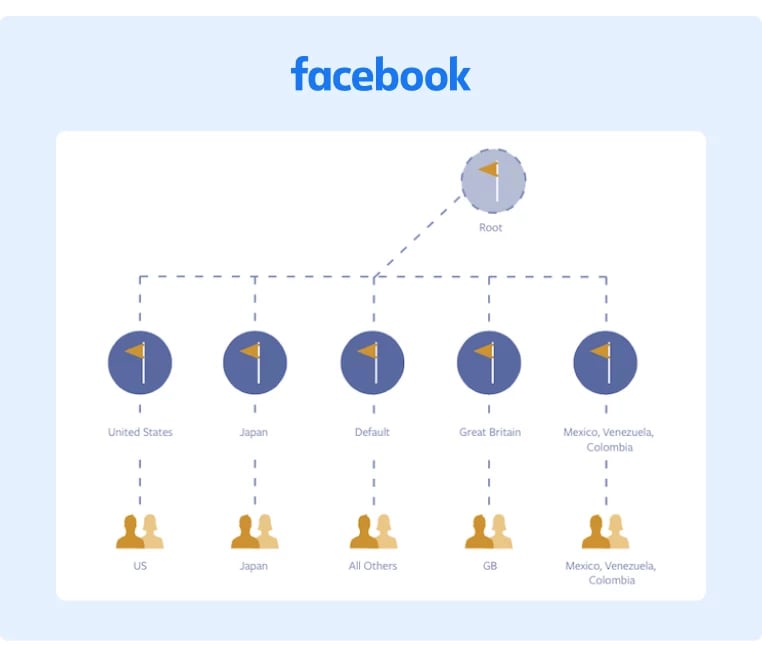
For each Global page, you can create different Market pages to post targeted content in the local dialect to that audience. Each Market page automatically posts content in the local language, though you'll still want a local manager to double-check it for cultural accuracy.
If you have a social media team, delegation is easy, as Market pages have their own independent inbox, admins, timeline, profile/cover photos, and more.
A key benefit to Market pages is that you can promote targeted content to specific regions without splitting fan engagement across the main Global page.
For example, if you're launching a product only to the Asian market, you can show localized content promoting that product to the Asian audience. However, your Asian audience will still be able to see content published on the main Global page.
Most businesses only have one global LinkedIn account, and because most international business transactions take place in English, that's generally the most acceptable language to use.
However, you can create an About section for your LinkedIn profile in multiple languages. LinkedIn also allows you to target organic audiences from the company page.
To do so, simply click "Targeted audience"; then, you can select specific targeting options:

This is an excellent option if you need to promote a specific campaign to a particular audience in a different language.
Another hack is to use LinkedIn showcase pages. This is a strategy that Crystal Cummins, the Senior Social Media Manager at Corcentric, uses for their global social media strategy.
Specifically, they have a showcase page for Northern Europe and Southern Europe. Corcentric also has a fleet offering that’s separate from their core offering, so they have a separate showcase page for that as well.
“Creating separate pages makes it easier to deliver content that is more relevant and cohesive to the target audience,” says Crystal.
Unlike Facebook, Instagram does not allow you to create global pages. So if you post content on one page, someone in China will view the exact same content as someone in the United States.

Unfortunately, this means that people who don't speak the language of the global account probably won't understand the content, which can negatively impact engagement. However, this might be okay because Instagram is a highly visual platform.
The bigger issue is that you can't promote specific products or campaigns to particular audiences. For this reason, many companies prefer to use localized handles. For example, Starbucks has a specific Instagram handle for Hong Kong so that they can promote relevant content and collaborate with local influencers:
The downside of creating localized handles is that it will split your engagement, and you'll probably have to have an entire content creation team for each geographic location.
So if you use a single global account, use local hashtags to promote specific offers to specific geographic locations.
Twitter doesn't allow you to target specific locations, so you can choose to have a single global brand account or create multiple accounts for each target location.
If you have a different account for each location, you'll be able to create more targeted content for that audience and probably see higher engagement rates.
The downside to having multiple Twitter accounts for different regions is that it will split the total engagement of the global Twitter account. In addition, it's expensive to manage different content strategies for different regions.
Nevertheless, it might be a good option if you have the resources to create unique content. Spotify is a great example of a brand that has a single global brand account as well as different Twitter accounts for other geographic regions:

Global Social Media Marketing Best Practices
Whether you create individual accounts for each region or leverage specific features like Facebook's Market pages, you'll probably create some content specific to a particular region. So here are some best practices to keep in mind.
Identify Effective Platforms
First, look at which social networks your consumers use the most, then decide whether you want to create a regional or global content strategy for each platform.
For example, if your audience uses Instagram more than Twitter, you might decide to create multiple Instagram handles for each region yet have only one global Twitter account.
Learn About Local News and Culture
Now that you know which platforms you plan to create localized content for, whoever manages that region's social media accounts needs to stay up-to-date with the local news.
This is important for a few reasons.
First, if a local tragedy occurs, your brand might seem insensitive if you continue promoting sales and other initiatives. For example, Kylie Jenner was under fire for promoting a new lip gloss when the war in Ukraine broke out.

In other cases, your brand might appear deaf to cultural differences.
For example, the mineral water brand Evian posted a seemingly innocent tweet asking who had already drunk a liter of Evian that day. Unfortunately, the Tweet coincided with the first day of Ramadan, when millions of Muslims begin fasting.
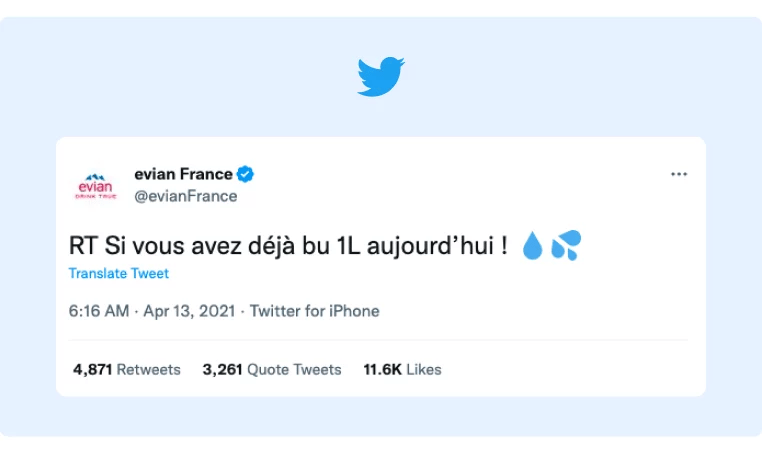
They received strong backlash for the unintentionally insensitive Tweet, which could have been avoided if someone on their social media team had been more culturally aware.
In contrast, capitalizing on positive local trends and fads is a great way to earn more engagement. For example, McDonald's Pakistan created a social media post wishing the Pakistani team luck in the World Cup:
Hiring a native person who still lives in that geographic area to manage the account is usually the most effective method to stay up to date with local news.
If that isn't possible, you can use a tool like Feedly or follow trending hashtags on social media to stay up-to-date with local news.
You can also use a local calendar with key holidays to ensure you don't accidentally create a promotional campaign that overlaps with a critical holiday.
Double Check Translations and Local Dialect
Avoid using an automated translator like Google when creating content for specific regions, as there are often nuances in the local dialect.
For example, The American Dairy Association made a fool of itself when using a translator to promote its "Got Milk?" campaign in Spain. This is because the literal translation reads the same as "Are you lactating?" in Spanish. Needless to say, Spanish customers were a little confused about the messaging, and the campaign ultimately fell flat.

So even if you can't afford to hire a full-time social media expert from the region you're marketing in, consider hiring a freelance translator from that geographic region to double-check translations.
You can even hire a freelancer on Upwork for $20-$40 per hour to help you with this.

Leverage Influencers From Each Region
Another benefit of creating content for specific regions is that you can work with local influencers popular in that demographic.
This is beneficial for a few reasons:
- The campaigns will resonate more with that regional audience.
- It's usually cheaper to collaborate with micro-influencers.
For example, Bed Bath and Beyond is another global brand that collaborated with Mexican decor micro-influencer Flor Martinez. They posted the campaign on the Bed Bath and Beyond Mexico account, and it was well received.
Incorporate Local Hashtags
Each region usually also has its own unique hashtags, which you can incorporate into your post for additional reach. For example, before the FIFA World Cup, the Mcdonald's Pakistan account used hashtags trending in the Pakistan community, like #PAKVSENG.

While you can search for hashtags manually, many apps can automatically suggest popular hashtags. Here are just a few of the most popular hashtag finders:
By adding hashtags to your posts, you can increase visibility, and it's a great way to stay up to date with current events.
Leverage Employee Advocacy For Promotion
Another great way to create a global social media presence is to leverage your employees to share content and help it get more initial traction. This is a particularly helpful tactic for B2B brands that don't have inherently popular products or services.
Stryker is an excellent example of a B2B company that effectively leverages employee advocacy to promote its social media content. This post is an excellent example of employee advocacy in action:
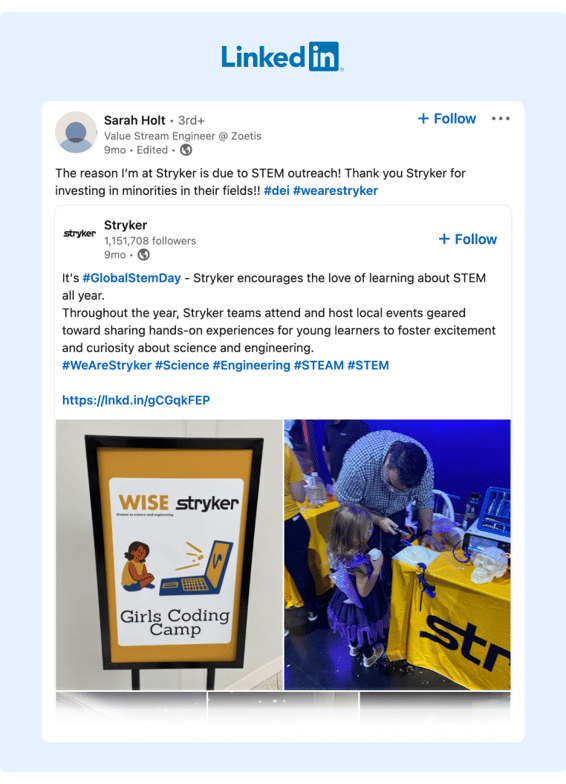
As you can see, even getting just a handful of your employees to engage with the brand's social media content can significantly increase each post's reach.
So if employee advocacy is so effective, why don't more brands leverage it?
Unfortunately, convincing employees to engage consistently with branded content is challenging. While they might take action the first few times you ask, your requests will likely become ignored over time.
To solve this problem, we built GaggleAMP.
It increases employee engagement and decreases your workload by allowing you to assign specific engagement activities to employees at scale.
Here's how it works:
Step 1: Select an engagement activity for a social media platform (e.g., like on Facebook, comment on LinkedIn, share on Instagram, etc.).
Step 2: Fill out that engagement activity with the exact post you want them to engage with and any additional instructions.

Step 3: You can assign that engagement activity to specific employees or a group of employees.
Step 4: Employees receive a notification that they have an engagement assignment and can log into their Gaggle to complete it.

Step 5: After completing the activity, employees can schedule it to publish later. This way, employees only need to devote a few minutes to employee advocacy each week, and your brand will have consistent engagement throughout the week.
GaggleAMP also has a public leaderboard that shows which employees are most engaged. This makes it easy for you to reward the most engaged employees, and it also inspires friendly competition to further motivate employees to engage.
To see for yourself if GaggleAMP is a good fit for your team, schedule a demo today or sign up for a free trial!
Building a Global Social Media Marketing Team and Workflow
Most global brands require a team to run the global brand strategy, so here’s how you can build a team and implement a workflow that helps you build a successful team.
Step 1: Decide What You Want to Delegate
You can choose to hire a full-time social media assistant, or you can hire freelancers and part-time employees.
The first step to making this decision is determining what you want to delegate. Here are the various social media tasks that you could delegate:
- Research and post ideation
- Creative/copywriting
- Translation
- Optimization (hashtags, CTAs, etc.)
- Collaboration outreach
If you choose to outsource all of the tasks above, you'll probably hire a full-time employee, though you could just hire a freelance designer/creative person and maybe a local translator.
In our conversation with Corcentric’s Senior Social Media Manager, Crystal Cummins, she mentioned that she typically collaborates with the content director, campaign manager, and graphic design team.
To ensure everything is delivered on-time, Corcentric uses a standard project management tool. This way, everyone can see what the rest of the team is working on and it ensures that all content is delivered on time.
Step 2: Hire Locals
Whether you choose to hire a freelancer or a full-time employee, it's a good idea to hire someone native to the geographic region you're planning to have them manage.
Crystal also mentioned that hiring regional talent is essential to Corcentric’s global social media marketing strategy.
“For example, we have a team member in France who guides creative and messaging decisions to ensure the content resonates with that audience,” says Crystal.
So how can you find a social media assistant/content creator in a specific geographic region?
If you're hiring a freelancer, you can use a platform like Upwork or Dribbble (for designers).
If you decide to hire a full-time professional, you can reach out on LinkedIn to native social media managers in the area you're targeting. For example, you can add a title like "social media manager" and filter by region:

As you search through different profiles, you can look at their past work history, certifications, and read through some of their posts.
A positive sign that someone might be a superstar is if they have been promoted multiple times in their current company. It's also wise to read through any content they've posted on LinkedIn to better understand how they think about social media.
Step 3: Create Branding Guidelines and a Social Media Policy
As the team grows, it will be more difficult to ensure the brand's vision and messaging remains consistent. So to prevent any issues, create clear branding guidelines that outline the following topics:
- Brand vision/core values
- Logistical details (logo, colors, fonts, etc.)
- Off-limits topics
- Crisis protocol
If you're working with freelancers, you can still send this guide to them, as it will help answer many follow-up questions when they start working with you.
This topic has a lot of nuances, so we created an entire resource on building a social media policy.
Step 4: Establish a Content Workflow
As your content marketing team grows, you'll probably work with designers, videographers, copywriters, and other specialized professionals.
In addition, you might be collaborating with other department heads for quotes and other content snippets.
So to ensure you're still publishing content consistently and each post coincides with important launches, leverage a project management or social media management tool.
For project management, you can use a tool like Asana or Monday.com, though if you want a tool that's more specific to social media, consider using a tool like Buffer.
Crystal also mentioned that project management tools are essential to keeping Corcentric’s global team aligned. She typically collaborates with the content director, campaign manager, and creative team on any given social media campaign, so using a project management tool helps keep all people aligned and sets clear expectations.
Regardless of which tool you select, it should include basic functionalities like internal communication among team members, due date scheduling, and project media storage.
This way, you can easily oversee project progress and ensure each team member stays on top of their respective tasks.
Another key aspect of Corcentric’s global social media marketing strategy are alignment meetings. While meetings can be time wasters, a quick 10 or 15 minute call that ensures each team member understands their role in a project can save hours of redoing work and avoid missed deadlines.
In addition, if you have to pivot on a plan, meetings are a great way to re-establish expectations.
Step 5: Analyze Top Performing Channels and Content
As you create content for multiple regions, you'll probably find that some channels and content perform better in specific regions.
Crystal confirmed this by adding that “Tracking the right metrics so that you can tell what’s working and double down on that is critical.”
This applies to both channels and content formats.
For example, from a channel perspective, Crystal noticed that they were earning a lot of engagement from Twitter. Therefore, they decided to double down on that channel.
Additionally, some types of content and messages might perform better in some regions than others.
For example, a campaign promoting healthy body images might perform very well in the United States yet fall flat in a country like South Korea. This is also a great example of how leveraging a local from that region to guide strategy can be helpful.
So rather than just analyzing global engagement metrics, it's important to also analyze each region's performance. Here are just a few key metrics you can measure:
- Average post engagement (comments, likes, reshares)
- Follower growth rate
- Brand mentions
- Total leads initiated from social media
While all the metrics above are quantitative, it's also important to measure qualitative data like comment quality and brand sentiment.
Improve Your Global Social Media Strategy Today
Creating a global social media marketing plan is about building systems and processes that make delegation easier and staying in-tune with consumer behavior across various regions.
So try out the global marketing strategy outlined above and keep an open line of communication with your team to improve the process.
You can also involve your team in the process by encouraging them to promote key company initiatives with their social media networks. If you want a tool that makes it super easy to assign specific engagement tasks to employees, consider using GaggleAMP. You can schedule a demo or try it out for yourself today!






